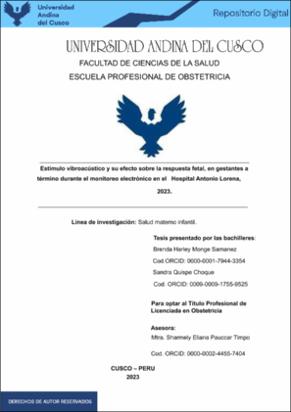| dc.contributor.advisor | Pauccar Timpo, Sharmely Eliana | |
| dc.contributor.author | Monge Samanez, Brenda Harley | |
| dc.contributor.author | Quispe Choque, Sandra | |
| dc.date.accessioned | 2024-03-19T15:26:09Z | |
| dc.date.available | 2024-03-19T15:26:09Z | |
| dc.date.issued | 2023-12-15 | |
| dc.identifier.uri | https://hdl.handle.net/20.500.12557/6139 | |
| dc.description.abstract | El estudio titulado “Estímulo vibroacústico y su efecto sobre la respuesta fetal, en gestantes a
término durante el monitoreo electrónico en el Hospital Antonio Lorena, 2023” tuvo como objetivo
determinar el efecto del estímulo vibroacústico sobre la respuesta fetal, en gestantes a término
durante el monitoreo electrónico en el Hospital Antonio Lorena, 2023. El método fue de enfoque
cuantitativo, correlacional, diseño no experimental, retrospectivo y corte transversal, tuvo una
muestra de 175 gestantes a término atendidas en el Hospital Antonio Lorena del Cusco, se aplicó
la técnica de la observación a través del uso de una ficha de recolección de datos. Los resultados
fueron que 29,7% se encontraban en el rango de edad de 26 a 30 años y el 35,4% en la semana
gestacional 38. Con relación al estímulo vibroacústico, el 47,4% recibieron de 1 a 2 estímulos con
una duración de 3 a 4 segundos, mientras que un 15,4% fueron sometidas de 3 a 6 estímulos de
similar duración. Se halló un efecto del estímulo vibroacústico con la respuesta fetal en: la
duración del estímulo vibroacústico y la frecuencia cardiaca fetal (p=0,002 v=0,265) indicando un
efecto significativo débil; la frecuencia de estímulos vibroacústicos y la variabilidad (p=0,000
v=0,285) indicando un efecto significativo débil; la frecuencia de estímulos vibroacústicos y las
aceleraciones (p=0,049 v=0,149) indicando un efecto significativo débil; la duración de los
estímulos vibroacústicos y las desaceleraciones (p=0,017 v=0216) indicando un efecto
significativo débil; la frecuencia de estímulos vibroacústicos y los movimientos fetales (p=0,031
v=0163) indicando un efecto | es_PE |
| dc.description.abstract | The study titled "Vibroacoustic Stimulus and Its Effect on Fetal Response in Term Pregnant
Women during Electronic Monitoring at Antonio Lorena Hospital, 2023" aimed to determine the
effect of vibroacoustic stimulus on fetal response in term pregnant women during electronic
monitoring at Antonio Lorena Hospital in 2023. The method used was a quantitative, correlational,
non-experimental, retrospective, and cross-sectional approach, with a sample of 175 term
pregnant women treated at Antonio Lorena Hospital in Cusco. Data collection was conducted using
observation techniques and a data collection form. The results showed that 29.7% of the
participants were in the age range of 26 to 30 years, and 35.4% were in gestational week 38.
Regarding the vibroacoustic stimulus, 47.4% received 1 to 2 stimuli with a duration of 3 to 4
seconds, while 15.4% were exposed to 3 to 6 stimuli of similar duration. The study found an effect
of the vibroacoustic stimulus on fetal response in the following aspects: the duration of the
vibroacoustic stimulus and fetal heart rate (p=0.002, v=0.265), indicating a weak but statistically
significant effect; the frequency of vibroacoustic stimuli and variability (p=0.000, v=0.285),
indicating a weak but statistically significant effect; the frequency of vibroacoustic stimuli and
accelerations (p=0.049, v=0.149), indicating a weak but statistically significant effect; the duration
of vibroacoustic stimuli and decelerations (p=0.017, v=0.216), indicating a weak but statistically
significant effect; the frequency of vibroacoustic stimuli and fetal movements (p=0.031, v=0.163),
indicating a weak but statistically significant effect. | en_US |
| dc.format | application/pdf | es_PE |
| dc.language.iso | spa | es_PE |
| dc.publisher | Universidad Andina del Cusco | es_PE |
| dc.rights | info:eu-repo/semantics/openAccess | es_PE |
| dc.rights.uri | https://creativecommons.org/licenses/by-nc-nd/4.0/ | es_PE |
| dc.subject | Estímulo vibroacústico | es_PE |
| dc.subject | Cardiotocología | es_PE |
| dc.subject | Respuesta fetal | es_PE |
| dc.title | Estimulo vibroacústico y su efecto sobre la respuesta fetal, en gestantes a término durante el monitoreo electrónico en el Hospital Antonio Lorena, 2023. | es_PE |
| dc.type | info:eu-repo/semantics/bachelorThesis | es_PE |
| thesis.degree.name | Licenciada en Obstetricia | es_PE |
| thesis.degree.grantor | Universidad Andina del Cusco. Facultad de Ciencias de la Salud | es_PE |
| thesis.degree.discipline | Obstetricia | es_PE |
| dc.publisher.country | PE | es_PE |
| dc.subject.ocde | https://purl.org/pe-repo/ocde/ford#3.02.02 | es_PE |
| renati.advisor.dni | 44975718 | |
| renati.advisor.orcid | https://orcid.org/0000-0002-4455-7404 | es_PE |
| renati.author.dni | 72117688 | |
| renati.author.dni | 72506076 | |
| renati.discipline | 914016 | es_PE |
| renati.juror | Soto Bringas, Rosario Isabel | |
| renati.juror | Leon Villalobos, Yolanda Victoria | |
| renati.juror | Huacasi Herrera, Maria | |
| renati.juror | Huamanga Gamarra, Bertha | |
| renati.level | https://purl.org/pe-repo/renati/level#tituloProfesional | es_PE |
| renati.type | https://purl.org/pe-repo/renati/type#tesis | es_PE |




